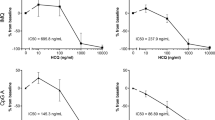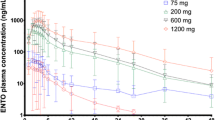Abstract
A-285222 (A-285) is a bis-trifluoromethyl-pyrazole (BTP), a novel class of immunosuppressive agents that inhibit NFAT activity in vitro in human and non-human primate cells through a calcineurin-independent mechanism. In this preliminary study, we treated cynomolgus monkeys with different doses of A-285 for several days. Blood was collected from all animals at different times during the study. From these samples, plasma concentrations of A-285 were measured by liquid chromatography/mass spectrometry (LC/MS), and intracellular T-cell production of the cytokines IL-2, IFN-γ, and TNF-α was quantified by flow cytometry using a mitogen-stimulated whole blood assay. Marked inhibition of cytokine production occurred after administration of the first dose of A-285, and this effect was comparable to that of cyclosporine. While neurological toxic side effects were seen when the plasma concentration of A-285 exceeded 4 µg/ml, at lower plasma levels the drug was well tolerated over 2 weeks and its pharmacodynamic effects were sustained throughout this time.


Similar content being viewed by others
References
Schreiber SL, Crabtree GR. The mechanism of action of cyclosporine A and FK506. Immunol Today 1992; 13:136.
Sigal NH, Dumont F, Durette P, et al. Is cyclophilin involved in the immunosuppressive and nephrotoxic mechanism of action of cyclosporine A? J Exp Med 1991; 173:619.
Dumont FJ, Staruch MJ, Koprak SL, et al. The immunosuppressive and toxic effects of FK-506 are mechanistically related: pharmacology of a novel antagonist of FK-506 and rapamycin. J Exp Med 1992; 176:751.
Ho AM, Jain J, Rao A, Hogan PG. Expression of the transcription factor NFATp in a neuronal cell line and in the murine nervous system. J Biol Chem 1994; 269:28181.
Kiani A, Rao A, Aramburu J. Manipulating immune responses with immunosuppressive agents that target NFAT. Immunity 2000; 12:359.
Rao A, Luo C, and Hogan PG. Transcription factors of the NFAT family: regulation and function. Annu Rev Immunol 1997; 15:707.
Trevillyan JM, Chiou XG, Chen YW, et al. Potent inhibition of NFAT activation and T-cell cytokine production by novel low molecular weight pyrazole compounds. J Biol Chem 2001; 276:48118.
Chen Y, Smith ML, Chiou GX, et al. TH1 and TH2 cytokine inhibition by 3,5-bis (trifluoromethyl) pyrazoles, a novel class of immunomodulators. Cell Immunol 2002; 220:134.
Djuric SW, BaMaung NY, Basha A, et al. 3,5-Bis (trifluoromethyl) pyrazoles: a novel class of NFAT transcription factor regulator. J Med Chem 2000; 43:2975.
Poston RS, Robbins RC, Chan B, et al. Effects of humanized monoclonal antibody to rhesus CD11a in rhesus monkey cardiac allograft recipients. Transplantation 2000; 69:2005.
Pierson RN III, Chang AC, Blum MG, et al. Prolongation of primate cardiac allograft survival by treatment with anti-CD40 ligand (CD154) antibody. Transplantation 1999; 68:1800.
Yang H, Chen G, Kanai N, et al. Monotherapy with LF 15-0195, an analogue of 15-deoxyspergualin, significantly prolongs renal allograft survival in monkeys. Transplantation 2003; 75:1166.
Hausen B, Klupp J, Christians U, et al. Coadministration of either cyclosporine or steroids with humanized monoclonal antibodies against CD80 and CD86 successfully prolong allograft survival after life-supporting renal transplantation in cynomolgus monkeys. Transplantation 2001; 72:1128.
Christians U, Jacobsen W, Serkova N, et al. Automated, fast and sensitive quantification of drugs in blood by liquid chomatography-mass spectrometry with on-line extraction. J Chromatogr B Biomed Sci Appl 2000; 748:41.
Liu W, Youn HD, Zhou XZ, Lu KP, Liu JO. Binding and regulation of the transcription factor NFAT by the peptidyl prolyl cis-trans isomerase Pin1. FEBS Lett 2001; 496:105.
Leverson JD, Ness SA. Point mutations in v-Myb disrupt a cyclophilin-catalyzed negative regulatory mechanism. Mol Cell 1998; 1:203.
Renoir JM, Mercier-Bodard C, Hoffmann K, et al. Cyclosporin A potentiates the dexamethasone-induced mouse mammary tumor virus-chloramphenicol acetyltransferase activity in LMCAT cells: a possible role for different heat shock protein-binding immunophilins in glucocorticosteroid receptor-mediated gene expression. Proc Natl Acad Sci U S A 1995; 92:4977.
Acknowledgements
This research was supported by grants from the Max Kade Foundation, New York, N.Y., the Ralph and Marian Falk Trust, the Hedco Foundation, and Abbott Laboratories, Abbott Park, Ill.
Author information
Authors and Affiliations
Corresponding author
About this article
Cite this article
Bîrsan, T., Dambrin, C., Marsh, K.C. et al. Preliminary in vivo pharmacokinetic and pharmacodynamic evaluation of a novel calcineurin-independent inhibitor of NFAT. Transpl Int 17, 145–150 (2004). https://doi.org/10.1007/s00147-003-0676-1
Received:
Revised:
Accepted:
Published:
Issue Date:
DOI: https://doi.org/10.1007/s00147-003-0676-1




